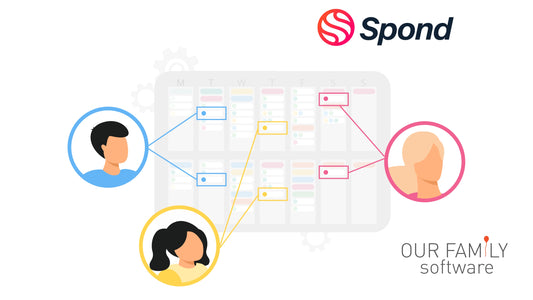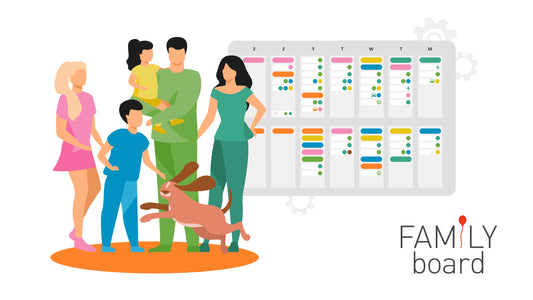Meal planning and weekly grocery shopping go together. If you do not know what you are going to eat, you do not know what to buy. In short, there are 3 things that are important when you plan your weekly shop:
- How much time you have
- Who will be eating
- What items you have in stock
By following the list below, anyone can manage a weekly shop. And we promise you - the next time it will get easier!
1. Overview of your schedule
Without this overview, it is impossible to create a plan. This overview will tell you how much time there is to both prepare and eat the meals, as well as who will be present for those meals.
Maybe you have received an invitation for dinner? Well, that day you will not need dinner. Hooray!
Maybe you're having guests? Well then you need to plan for more portions and maybe a dessert?
Special occasion coming up? Maybe you need to prepare a favorite meal or bake a cake. Or maybe you need to buy balloons?
Sounds simple? Well, for a busy family it can be difficult to get an overview of the week schedule. We have previously written about how to get an overview of the whole family's agenda. You can find the article here.
2. Plan your next shopping trip
When you know when your next shopping trip will be, then you also know how many days you should plan meals for. Some people like to shop on the same day every week, but if your family life is not routine, it may be easier not to have a fixed grocery shopping day.
Maybe your partner is on a business trip, it will be difficult to get to the shop? Well then it would be smart to plan for 10 days instead of 7 days. Actually planning for 7 or 10 days is much the same when you have a meal plan - but it may have an enormous effect on the stress levels of busy days.
3. Check your fridge and freezer
You can save the most time and money on the items that you avoid buying! So plan to use the goods you have at home before they are out of date.
Maybe you have some frozen shrimp that you can make into a quick fish chowder? And what about the half a package of sausages that needs to be used before its expiration date. Or maybe you have several tins of tuna that have been left from dinners planned, but not cooked.
Use as much as possible of what you already have at home for a simpler and cheaper shopping trip.
4. Write down a meal plan
When you know the schedule, use this to plan your menu. It is always useful to have a list or book of recipes that you normally make or wish to explore.
|
TIP 1: Make a list of alternative meals Start by writing down the meals you plan for this week, and fill the list with more recipes next week or when they come to you. It may be helpful to categorize the list into weekend/weekday, meat/fish or quick/slow-cooked meals. |
"Leftovers" should be a meal every week to avoid food waste. If there is not enough leftovers to go around, add something from the freezer og make "croque monsieurs" so that everyone gets their fill.
Most families have some unwritten rules about what a meal consists of, or how often you eat certain things. Take these rules into account when you create your meal plan. If you use a list of recipes for you meal planning, you will realize that is easy to have a varied diet when you meal plan.
|
TIP 2: Agree on the family meal rules Often these rules are unwritten, but maybe it is a good idea to discuss them? What is weekday vs. weekend meals in your family? What's important when you plan your meals? Should there always be vegetables or are there exceptions? |
We often only think of dinner when we meal plan. But do not forget to add any other meals or recipes you may need. If you bake your own bread, this recipe needs to be included so you don't forget to buy the ingredients. Maybe you need to bake something for a sports event, or you want something special for breakfast or waffles on the weekend? Are you going on a hike and need food for the trip? If you go through the schedule for the days you plan for, nothing will be forgotten!
|
TIP 3: Download Meal Planner template We have made a simple and beautiful template for a meal plan. In this template you can also add suggestions for future meals and your list of recipes. You can download the template here: |
5. Create a grocery list from the meal plan
If you have the recipes written down or stored digitally, then you don't need to remember the ingredients. This process will be much simpler the next time you create a grocery list.
|
TIP 4: Download Grocery List template We have made a simple and beautiful template that makes it easy to get started, You can customize the template with your standard items and change the categories and order of them so that the list fits with your supermarket layout. You can download the template here: |
6. Add items that you should always have on hand
Items that you always need on hand which you use for breakfast, packed lunches and snacks must not be forgotten! These are items that may not be planned for specifically. Typical items are fruit, sandwich toppings, cereals, yoghurts, milk, frozen bakeries, oatmeal, raisins, ketchup etc. Create a list of all the items your family uses every week, then use this list to complete your grocery list.
There are also certain household items you do not want to go without such as toilet paper, kitchen roll, washing liquid etc. Include these items on your list of items to add to the grocery list. It it easier to recognize what you need when you have this list in front of you.
Creating a precise list of these items will save you many trips to the shop.
7. Check what you already have and remove items from list
This step does not take very long, but is very important to avoid filling up cupboard and avoiding food waste.
Cross out or remove items you do not need to buy from your list.
8. Grocery shop using the shopping list
If your grocery list is categorized according to the supermarket layout, the shopping trip should be efficient if you shop in a physical store or online.
Since you have done such a good job at creating your list, why not grocery shop in the evening or early morning to avoid a queue?
You are allowed to be creative and replace items on the list. Maybe there is an offer on, or there are seasonal items for sale? You are allowed to be tempted to shop for an additional meal or replace a planned meal - but remember to update the meal plan when you get home.
The beauty of a grocery list is that you do not need to remember stuff, so you have time to be inspired and can focus on other things! But do not stray too far from your list, as you may end up buying more than you can eat!
9. Make the meal plan available to others
If you serve a fish bake on Monday or Tuesday, it does not really matter. But it is useful for the first person that gets home in the afternoon to know which meals are planned for, so they can start the job of making it.
A visible meal plan also shows you how many days you have planned for, and when you need to plan new meals and create a new grocery list.
Another benefit of visualizing, is that the children are more prepared for what is for dinner, and this actually means less complaining when you sit down at the table! Who doesn't love that?
You are now all set for a stress-free and lovely familymeal!
Bon appétit!
Still not convinced? Here are some of the many benefits of weekly grocery shopping:
- Save time by going to the supermarket only once
- Save money by only buying what you need
- Eat more varied and healthier
- Less food waste
- Everyone has a say in the menu
- More likely to have time for family meals
- No stressful planning at the end of the work day
- Less stress and fewer discussions on what to have for dinner
- A more harmonious family life!
Find out more about FamilyBoard






